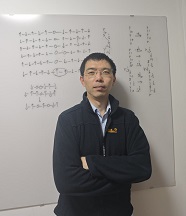- Speaker
- Prof. Xue-Feng Zhang
- Chongqing University
- Abstract
Significant research advances have led to a consensus that the Fermi-Hubbard model and its extended variants are archetypal frameworks for elucidating the intertwined relationship between stripe orders and superconductivity in hole-doped high-Tc materials. Notably, the Hubbard quantum simulator has recently achieved several remarkable breakthroughs, e.g., being successfully cooled down to the cryogenic regime and enabling the observation of stable fluctuating stripes. However, the microscopic mechanism behind d-wave pairing of electrons in the presence of stripes at low temperatures remains poorly understood due to the intricate interplay among the strongly correlated effects and non-negligible thermal fluctuations. Here, we conduct a close investigation of a partially-filled stripe in the representative t-J and t-t′-U models with both numerical and analytical methods. Analogous to quantum gas microscopy, the perfect sampling technique allows us to obtain the high-confidence statistics of the Fock basis states appearing in the ground-state wavefunction. In a refreshing physical paradigm, these data demonstrate that two spinons with opposite chiralities tend to spontaneously pair into a singlet state, which naturally gives rise to the d-wave pairing pattern. Then, using the effective theory of quantum colored string, we reconstruct the wavefunction and determine the nature of spinon pairing and its connection to the d-wave pairing pattern. Furthermore, spinon singlet pairs enable the establishment of a long-range pair-pair correlation between double stripes. Our work offers new insights into the role of stripe orders in mediating d-wave superconductivity and paves the way for further exploration of multi-stripe-mediated pairing mechanisms in the Fermi-Hubbard model.
- About the Speaker
Prof. Dr. Xue-Feng Zhang, obtained a doctoral degree from the Institute of Theoretical Physics, the Chinese Academy of Sciences in 2011. Then, as a postdoc, he worked at the Technical University of Kaiserslautern and the Max-Planck Institute for the Physics of Complex Systems. Now, he is a professor at Chongqing University, China. His main research interest is focusing on the theory of quantum many-body systems, especially the topological phase of matter and ultra-cold atoms in an optical lattice.
- Date&Time
- 2025-11-19 10:00 AM
- Location
- Room: A303 Meeting Room




